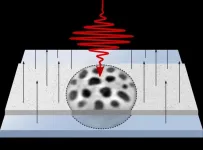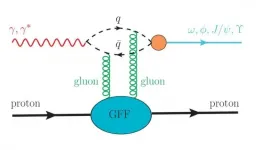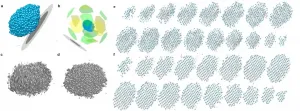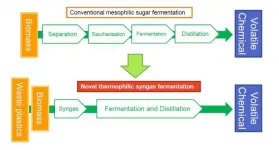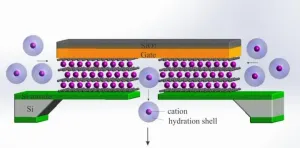New algorithm to ensure more accuracy in studying the interior of the Earth
Geophysicists have developed an algorithm of joint interpretation of two approaches to exploration of the Earth's subsurface. The developed algorithm ensures more accuracy in engineering investigations.
2021-05-12
(Press-News.org) An essential preliminary to building and construction or resource extraction is studying the geological structure of the site. One of steps of this process is geophysical investigation. This provides a continuous overview of the geological horizons rather than just data on points: boreholes. The standard methods of geophysics help successfully solve this problem in comparatively simple conditions. Yet the classical direct current methods may lead to serious inaccuracy if we have to investigate geologically complex structures with thin layers of sandy and clayey soils.
Among the most popular methods in geoelectrical survey is electrical resistivity tomography (ERT). It is a geophysical method for imaging subsurface structures by electrical resistivity measurements made at the surface or in boreholes. It allows geologists to 'see' various rock formations as they have different resistivity. Yet the electrical resistivity tomography can also result in serious inaccuracy in measuring geologic layer thickness, and therefore lead to a considerable increase in values.
'Errors in estimation of the electrical properties of the soils may lead to mistakes in pile construction and other problems during building. When we explore the deposit of the sands, such errors can lead to wrong data about sand reserves. You never know what is below the earth's surface. If we interpret our data following formal approach only it is a huge chance to have mistakes,' said Arseny Shlykov, the first author of the research, PhD and senior researcher at the Institute of Earth Sciences at St Petersburg University .
Electrical resistivity tomography (ERT) is not the only method to investigate the Earth's subsurface. A relatively new radiomagnetotelluric (RMT) method is being developed by geophysicists at St Petersburg University and their colleagues at: the Institute of Geophysics and Meteorology (IGM), the University of Cologne (Germany); and Indian Institute of Technology Kharagpur (IIT Kharagpur). It uses electromagnetic field of remote radio transmitters, and provides information about the subsurface to depths from 1 to 30-50 metres. If we use controlled source radiomagnetotelluric (CSRMT), we can study the subsurface down to 100 - 150 metres.
'If we use both methods in one site with complicated geoelectrical section, we can get different results. It is because significantly different structure of the electromagnetic field used in CSRMT and ERT methods. But the joint inversion of CSRMT and ERT data allows to use benefits of both methods and get more accurate results. This is the reason why we needed an algorithm to join them,' said Arseny Shlykov.
The field experiment was carried out on the field testing site of Lomonosov Moscow State University that is located in the settlement of Aleksandrovka in the Kaluga region. The international team of geophysicists compared the results obtained using both methods and interpreted obtained data both separately and jointly. The data obtained using the newly developed algorithm was the closest to the borehole data.
'The newly developed algorithm is a one more step forward to ensuring more accuracy of geophysical exploration. This algorithm works within a one-dimension horizontally layered vertically anisotropic model of the Earth. The one-dimensional models are simplest. They represent the subsurface as a puff pastry pie with multiple horizontal layers. The properties of the rocks in such models can change in one direction only, i.e. downward. That's why such models are called one-dimensional. Obviously, the geological media is more complex. We are planning to continue developing the algorithm to be able to use it with two- and three-dimensional geological models. Two-dimensional models represent both vertical and lateral changes. Yet the lateral changes are also in one direction only. Three-dimensional models are most complex and close to what we have in real life. Yet using three-dimensional models is not an easy task. It is rather resource-intensive and time consuming,' said Arseny Shlykov.
INFORMATION:
[Attachments] See images for this press release:

ELSE PRESS RELEASES FROM THIS DATE:
2021-05-12
Leipzig/Jena/Ilmenau. Mobile apps like Flora Incognita that allow automated identification of wild plants cannot only identify plant species, but also uncover large scale ecological patterns. These patterns are surprisingly similar to the ones derived from long-term inventory data of the German flora, even though they have been acquired over much shorter time periods and are influenced by user behaviour. This opens up new perspectives for rapid detection of biodiversity changes. These are the key results of a study led by a team of researchers from Central Germany, which has recently been published in Ecography.
With the help of Artificial Intelligence, plant species ...
2021-05-12
The gopher tortoise (Gopherus polyphemus) is declining because of habitat loss and fragmentation, human interaction including collisions with vehicles, predation by domestic animals, and disease. These long-lived reptiles are found throughout Florida and are affected by various diseases including upper respiratory tract disease. A number of pathogens such as Mycoplasma spp., Herpesvirus, and Ranavirus are known to cause upper respiratory tract disease in gopher tortoises. Chronic disease resulting from these pathogens can lead to reduced reproduction, abnormal growth and development, increased susceptibility to secondary ...
2021-05-12
Lysophospholipids are phospholipids that have just one fatty acid chain, and in recent years, the role of lysophospholipids in physiology and pathophysiology has attracted attention. Lysophosphatidylethanolamine (LPE) is a type of lysophospholipid that are reportedly present in the brain that consist of many species with different fatty acid chain lengths and degrees of unsaturation. The latest studies in animal models have reported elevated levels of LPE in the brain after traumatic brain injury and cerebral ischemia. Fluctuations in LPE concentration have also been reported in the plasma of patients with major depression and Alzheimer's disease. Although these reports suggest the involvement of LPE in brain function, the role of LPE in the brain has remained unclear.
Therefore, ...
2021-05-12
Smaller, faster, more energy-efficient: future requirements to computing and data storage are hard to fulfill and alternative concepts are continuously explored. Small magnetic textures, so-called skyrmions, may become an ingredient in novel memory and logic devices. In order to be considered for technological application, however, fast and energy-efficient control of these nanometer-sized skyrmions is required.
Magnetic skyrmions are particle-like magnetization patches that form as very small swirls in an otherwise uniformly magnetized material. In particular ferromagnetic thin films, skyrmions are stable at room temperature, with diameters down to the ten-nanometer range. It is known that skyrmions can be created and moved by short pulses of electric current. Only recently it was discovered ...
2021-05-12
Researchers have recently extracted the proton mass radius from the experimental data.
A research group at the Institute of Modern Physics (IMP) of the Chinese Academy of Sciences (CAS) presented an analysis of the proton mass radius in Physical Review D on May 11. The proton mass radius is determined to be 0.67 ± 0.03 femtometers, which is obviously smaller than the charge radius of the proton.
In the Standard Model, the proton is a composite particle made of quarks and gluons and it has a non-zero size. The radius of the proton is a global and fundamental property of the proton. It is related to the color confinement radius -- a property governed by quantum chromodynamics (QCD).
The radius of the proton is approximately 100,000 times smaller ...
2021-05-12
Atoms are the basic building blocks for all materials. To tailor functional properties, it is essential to accurately determine their atomic structures. KAIST researchers observed the 3D atomic structure of a nanoparticle at the atom level via neural network-assisted atomic electron tomography.
Using a platinum nanoparticle as a model system, a research team led by Professor Yongsoo Yang demonstrated that an atomicity-based deep learning approach can reliably identify the 3D surface atomic structure with a precision of 15 picometers (only about 1/3 of a hydrogen atom's radius). The atomic displacement, strain, and facet analysis revealed that the surface atomic structure and strain are ...
2021-05-12
The study conducted by the University of Turku and the Finnish Institute for Health and Welfare together with an international research team is so far the largest population-level study in the world examining the connection between human gut microbiota and health and mortality in the following decades.
The composition of the research subjects' gut microbiota was analysed from stool samples collected in 2002. The researchers had access to follow-up data on the subjects' mortality until 2017, i.e., close to the present day.
"Many bacterial strains that are known ...
2021-05-12
Acetone, a volatile solvent used for everything from removing nail polish and cleaning textiles to manufacturing plastics, could get a sustainability boost from a new strain of bacteria engineered by a research team based in Japan.
They published the details of the heat-loving, acetone-producing bacteria called Moorella thermoacetica on April 23 in AMB Express.
Acetone is typically produced through the widely used cumene method, which is cost-effective but not sustainable. The process, developed in 1942, involves converting two non-renewable resources into acetone and phenol, another chemical ...
2021-05-12
The human brain is a vast network of billions of biological cells called Neurons which fires electrical signals that process information, resulting in our sense and thoughts. The ion channels of atomic scale in each neuron cell membrane plays a key role in such firings that opens and closes the ion flow in an individual cell by the electrical voltage applied across the cell membrane, acting as a "biological transistor" similar to electronic transistors in computers. For decades, scientists have learned that biological ion channels are life's transistors capable to gate extremely fast and precisely selective permeation of ions through the atomic-scale selectivity filters to maintain vital living functions. However, ...
2021-05-12
Researchers from the £12 million Developing Human Connectome Project have used the dramatic advances in medical imaging the project has provided to visualise and study white matter pathways, the wiring that connects developing brain networks, in the human brain as it develops in the womb.
Published today in Proceedings of the National Academy of Sciences of The United States of America, the study used magnetic resonance images (MRI) with unprecedented resolution from more than 120 healthy fetuses across the second and third trimesters of pregnancy to define how the structural connections in their ...
LAST 30 PRESS RELEASES:
[Press-News.org] New algorithm to ensure more accuracy in studying the interior of the Earth
Geophysicists have developed an algorithm of joint interpretation of two approaches to exploration of the Earth's subsurface. The developed algorithm ensures more accuracy in engineering investigations.



